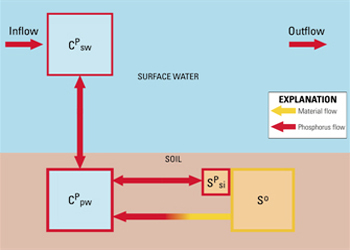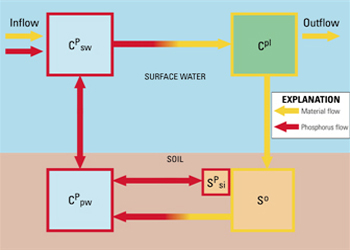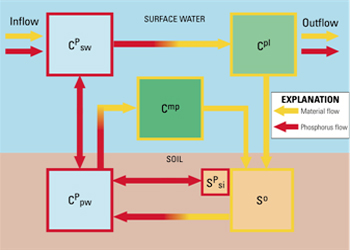Spatially-Distributed Modeling of Surface Water Phosphorus in the Southern Everglades Under Variable-Density Hydrodynamics
Participants: Stuart Muller, Rafael Muñoz-Carpena (UF), Eric Swain (USGS), Andrew James (SWET)
Timeline: September 2004 – September 2008 (Field Study); May 2005 – August 2010 (Data Analysis and Modeling)
Funding Agencies: USGS FL-WRC, South Florida Water Management District
Project Summary
Comprehensive water quality modeling in the southern Everglades is an essential step in the assessment of The Comprehensive Everglades Restoration Plan (CERP) flow scenarios, yet it remains largely unfulfilled because of a lack of models suitable for the task. Changes in flow patterns will have ecological consequences due to altered biogeochemical cycling in the southern Everglades and nutrient loading to Florida Bay. The region is also acutely vulnerable to the effects of sea-level rise and saltwater intrusion from the south, and climate change effects such as intensifying storm surges and altered freshwater flows due to changing upstream rainfall patterns and management. Of particular urgency is the need to assess changes in phosphorus biogeochemistry in the southern Everglades, which are naturally phosphorus-limited and contingent on hydrology, and subsequent nutrient loading to Florida Bay where the prevailing marine source of phosphorus may be diluted by increased freshwater flows. A number of keystone species that are important ecological indicators are sensitive to water quality, and the ecological models that track these populations need spatial and temporal biogeochemical data that could be generated by such a water-quality model.
This project has endeavored to integrate a powerful new water-quality model, the Reaction Simulation Engine (RSE), which was originally developed within this research group as the Transport and Reaction Simulation Engine (TaRSE; Jawitz et al., 2009), with the most advanced flow model for the complex hydrodynamics of the region, Flow and Transport in a Linked Overland-Aquifer Density Dependent System (FTLOADDS). The southern everglades are characterized by variable-density unsteady hydrodynamics, the consequence of salt and freshwater mixing, tidal effects, and extensive exchange between surface and groundwater. Since RSE relies on a connected model to compute and provide the necessary hydrodynamic inputs, mechanistic water-quality modeling in this region necessitates linkage with FTLOADDS.
Arguably most importantly, however, is the unique adaptability of RSE, which was developed to be user-defined, such that the modeler dictates the state variables of interest and the nature of the relationships between them. No other such tool exists, for the Everglades or elsewhere, that permits this within a spatially-distributed numerical modeling environment. This versatility effectively means that FTLOADDSaRSE can be readily adapted to model almost any system, including mobile and stabile (non-mobile) components, simply by redefining the conceptual model. It is therefore expected that this new tool will permit the rapid development of myriad water quality models for the southern Everglades without the need for further exorbitant model development costs.
Finally, no mention of modeling should go unaccompanied by mention of model uncertainty. Uncertainty is inextricably bound up with model complexity. The more complex the model the more accurate its reproduction of reality’s processes. However, each new process requires additional parameters and calibration data, all of which is subject to unavoidable measurement error that accumulates and eventually negates the gains made by adding complexity. The flexible structure of RSE affords a unique opportunity to experiment with complexity, and so optimize the water quality model to minimize uncertainty.



Project Impacts
Research findings will be used to assess the impact of flow management scenarios, proposed as part of the $10 billion Everglades restoration, on the water quality and ecology of the southern Everglades and Florida Bay.
Resource Links
- The Comprehensive Everglades Restoration Plan (CERP)
- Development and Implementation of a Transport Method for the Transport and Reaction Simulation Engine (TaRSE) based on the Godunov-Mixed Finite Element Method - USGS Scientific Investigations Report 2009-5034
- Development, Testing, and Sensitivity and Uncertainty Analyses of a Transport and Reaction Simulation Engine (TaRSE) for Spatially Distributed Modeling of Phosphorus in South Florida Peat Marsh Wetlands - Scientific Investigations Report 2008-5029
- TIME and SICS Modeling of Surface Water and Interactions with Ground Water - U.S. Geological Survey Flow and Transport in a Linked Overland-Aquifer Density Dependent System (USGS-FTLOADDS)
Publications
Refereed Publications
- Muller, S., R. Muñoz-Carpena (in preparation). Sense and sensitivity: Exploring the role of model complexity.
- Muller, S., R. Muñoz-Carpena (in preparation). Toward the unraveling of modeling’s sensitivity-uncertainty-complexity trilemma.
- Muller, S., R. Muñoz-Carpena (in preparation). Development and testing of a novel water-quality model for the southern Everglades.
Proceedings
- Muller, S.J., R. Muñoz-Carpena, K. Grace, J. Jawitz, K. Campbell, A. James. 2005. Design of a Phosphorus Model for South Florida based on a Simplified Approach. ASAE Paper No. 052252. St. Joseph, Mich.: ASAE.
- Muñoz-Carpena, R. and S.J. Muller. 2009. Formal Exploration of the Complexity and Relevance of Biogeochemical Models through Global Sensitivity and Uncertainty Analysis: Opportunities and Challenges. In: O. Silva Rojas and J. Carrera Ramírez (eds.). Estudios en la Zona no Saturada del Suelo, Vol. IX: 27-40. CIMNE: Barcelona.
Refereed Monographs
- Muñoz-Carpena, R., D. Kaplan and A. Ritter. 2009. Advanced Data Analysis of Shallow Groundwater Dynamics in the Loxahatchee River Floodplain[8.77MB]. Final Data Analysis Report to the South Florida Water Management District-Coastal Ecosystems Division, SFWMD Identifier: PO4500030399. November 2009. University of Florida: Gainesville.
- Muñoz-Carpena, R., D. Kaplan and F.J. Gonzalez. 2008. Groundwater Data Processing and Analysis for the Loxahatchee River Basin[13.7MB]. Final Project Report to the South Florida Water Management District-Coastal Ecosystems Division, SFWMD Identifier: 4500020860. August 2008. University of Florida: Gainesville.
Presentations & Posters
- Southern Everglades Water-Quality Modeling in an Uncertain Future: Stuart Muller, University of Florida, Gainesville, FL. Presentation: 2009 Annual Meeting of the Florida Section for the American Society of Agricultural and Biological Engineers, June 10-13, Daytona Beach, FL.
- Everglades Water Quality in an Uncertain Future: Stuart Muller, University of Florida, Gainesville, FL. Presentation: 2009 American Water Resources Association Spring Specialty Conference - Managing Water Resources Development in a Changing Climate, May 4-6, 2009. Anchorage, AK.
- A Spatially-Distributed Phosphorus Water-Quality Model for the Linked Surface-Water Groundwater Variable-Density Hydrology of the Southern Everglades: Stuart Muller, University of Florida, Gainesville, FL. Presentation: 2008 Greater Everglades Ecosystem Restoration Conference, July 28 - August 1, Naples, Florida.
- Development of a Spatially-Distributed Phosphorus Model for the Everglades: Stuart Muller, University of Florida, Gainesville, FL (R. Muñoz-Carpena, J. Jawitz, A. James). Poster session: 2008 AGU Joint Assembly – The Meeting of the Americas, May 27-30, Fort Lauderdale, FL.
- Characterizing Nutrient Transport in the Everglades: Stuart Muller, University of Florida, Gainesville, FL. Presenter: R. Muñoz-Carpena (S. Muller, R. Muñoz-Carpena, A. James, J. Jawitz, K. Grace), 2006 ASABE Annual International Meeting, July 9-12, Portland, OR.
- Design of a Phosphorus Model for South Florida Based on a Simplified Approach: Stuart Muller, University of Florida, Gainesville, FL (R. Muñoz-Carpena, J. Jawitz, K. Campbell, A. James, Y. Li). Poster session: 2005 ASAE Annual International Meeting, July 17-20, Tampa, FL.
- Design and Application of a Functional Phosphorus Model for South Florida Based on a Simplified Approach: Stuart Muller, University of Florida, Gainesville, FL (R. Muñoz-Carpena, J. Jawitz, K. Campbell). Poster session: Invasive Species and Agro-Ecosystems Research Partnership Workshop, UF-IFAS USDA-ARS, August 17, 2004, U.S. Horticultural Research Laboratory, Fort Pierce, FL.
This page was last updated on July 13, 2019.